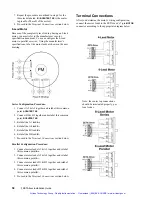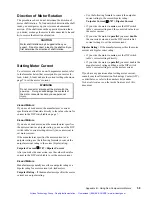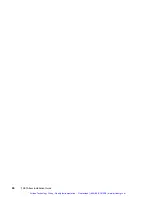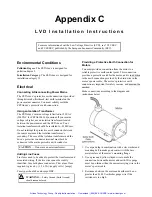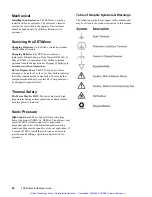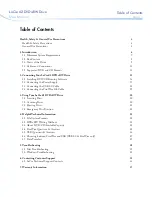
48
ζ
ZETA6xxx Installation Guide
Common Problems & Solutions
NOTE: Some software-related causes are provided because it is sometimes difficult to identify a problem as either hardware or software
related.
Problem
Cause
Solution
Communication
(serial) not
operative, or receive
garbled characters.
1. Improper interface connections or
communication protocol.
2. COM port disabled.
3. In daisy chain or multi-drop, the unit
may not be set to proper address.
1. See Troubleshooting Serial Communication section below.
2.a. Enable serial communication with the
E1
command.
2.b. If using RS-485, make sure the internal jumpers are set accordingly
(see page 8). Make sure COM 2 port is enabled for sending 6000
language commands (execute the
PORT2
and
DRPCHKØ
commands).
3. Verify DIP switch settings (see page 7), or proper use of
ADDR
command.
Direction is
reversed.
1. Phase of step motor reversed (motor
does not move in the commanded
direction).
2. Phase of encoder reversed (reported
TPE
direction is reversed).
1. Swap the A+ and A– connection at the MOTOR connector.
2. Swap the A+ and A– connection at the ENCODER connector.
SOFTWARE ALTERNATIVE: If the motor (and the encoder if one is
used) is reversed, you can use the
CMDDIR1
command to reverse the
polarity of both the commanded direction and the polarity of the encoder
feedback counts.
Distance, velocity,
and accel are
incorrect as
programmed.
1. Incorrect resolution setting.
1.a. Set the drive resolution to 25,000 steps/rev (
DRES25ØØØ
command).
1.b. Set the
ERES
command setting (default setting is 4,000 counts/rev)
to match the post-quadrature resolution of the encoder. Compumotor
encoders:
E Series Encoders ............................................
ERES4000
OS motor with -HJ encoder (OSxxx-xxx-HJ) ......
ERES2048
OS motor with -RE encoder (OSxxx-xxx-RE) .....
ERES4000
OS motor with -RC encoder (OSxxx-xxx-RC) ....
ERES4000
RS motor with -EC encoder (RSxxx-xxx-EC) .....
ERES4000
TS motor with -EC encoder (TSxxx-xxx-EC)*
Encoder counts
missing.
1. Improper wiring.
2. Encoder slipping.
3. Encoder too hot.
4. Electrical noise.
5. Encoder frequency too high.
1. Check wiring.
2. Check and tighten encoder coupling.
3. Reduce encoder temperature with heatsink, thermal insulator, etc.
4.a. Shield wiring.
4.b. Use encoder with differential outputs.
5. Peak encoder frequency must be below 1.6MHz post-quadrature.
Peak frequency must account for velocity ripple.
Erratic operation.
1. Electrical noise and/or improper
shielding.
2. Improper wiring.
1.a. Reduce electrical noise or move ZETA6xxx away from noise source.
1.b. Refer to Reducing Electrical Noise on page 46.
2. Check wiring for opens, shorts, & mis-wired connections.
LEDs See Diagnostic LEDs above (page 46)
Motion does not
occur.
1. Check LEDs.
2. End-of-travel limits are active.
3. P-CUT (Pulse cut-off) not grounded.
4. Drive fault detected.
5. Undervoltage (AC supply < 95 VAC).
6. Improper wiring.
7. Load is jammed.
8. No torque from motor.
1. See Diagnostic LEDs above.
2.a. Move load off of limits or disable limits with the
LHØ
command.
2.b. Set
LSPOS
to a value greater than
LSNEG
.
3. Ground the P-CUT connection.
4. Check status with
TASXF
command (see bit #4).
5. Check status with
TASXF
command (see bit #2). Check AC supply.
6. Check motor and end-of-travel limit connections.
7. Remove power and clear jam.
8. See problem: Torque, loss of.
Motor creeps at
slow velocity in
encoder mode
(
ENC1
).
1. Encoder direction opposite of motor
direction.
2. Encoder connected to wrong axis.
1. Switch encoder connections A+ & A- with B+ & B-.
2. Check encoder wiring.
Programmable
inputs not working.
1. IN-P (input pull-up) not connected to
a power supply.
2. If external power supply is used, the
grounds must be connected together.
3. Improper wiring.
1.a. When inputs will be pulled down to 0V by an external device, connect
IN-P to +5V supplied or to an external 5-24V positive supply (but not to
both).
1b. When inputs are pulled to 5-24V by an external device, connect IN-P
to 0V.
2. Connect external power supply's ground to ZETA6xxx’s ground (GND).
3. Check wiring for opens, shorts, and mis-wired connections.
Artisan Technology Group - Quality Instrumentation ... Guaranteed | (888) 88-SOURCE | www.artisantg.com

























